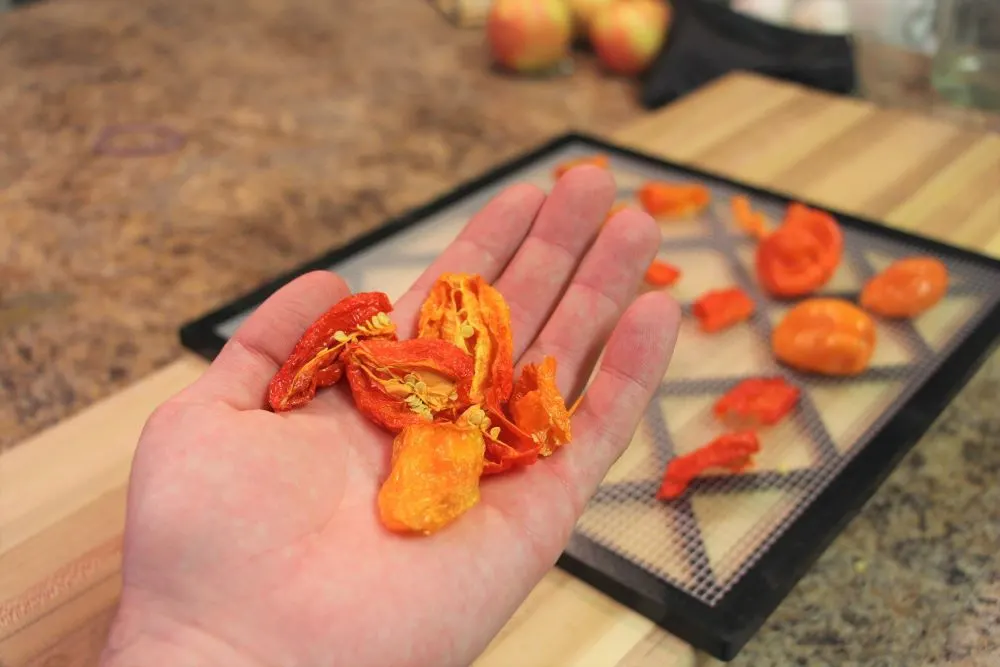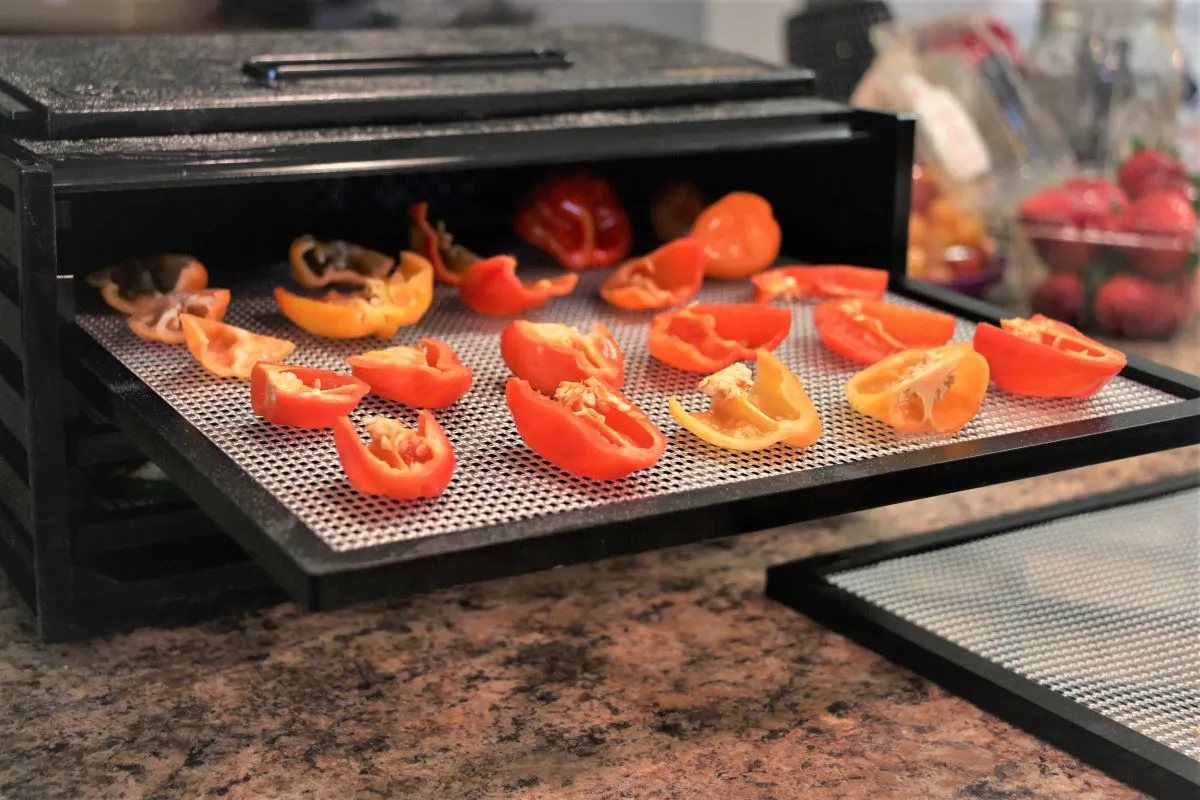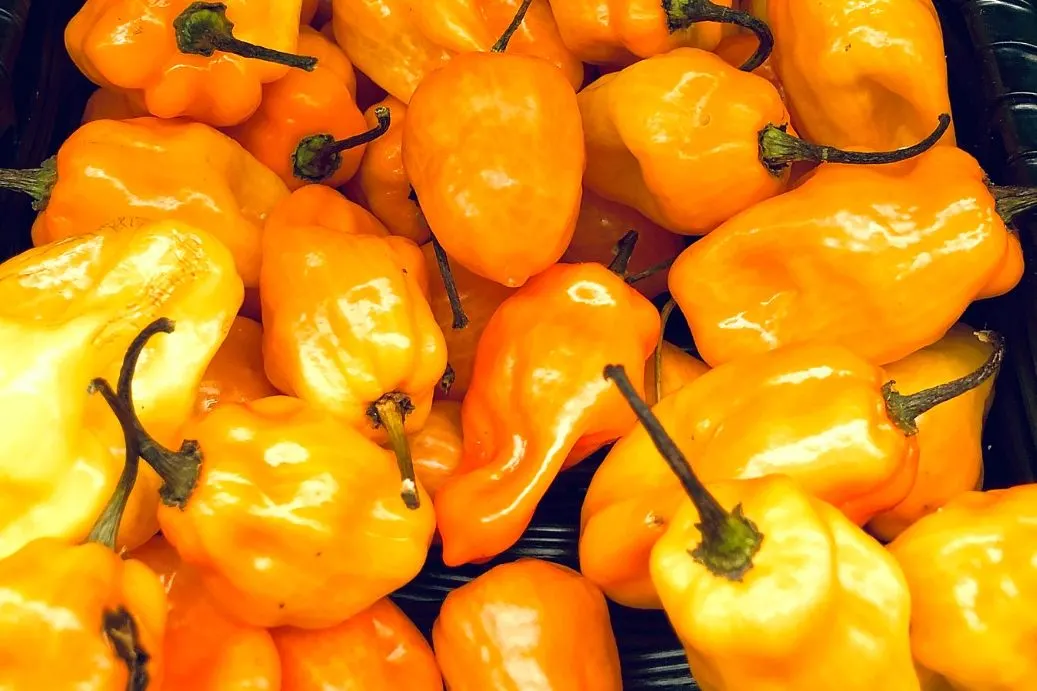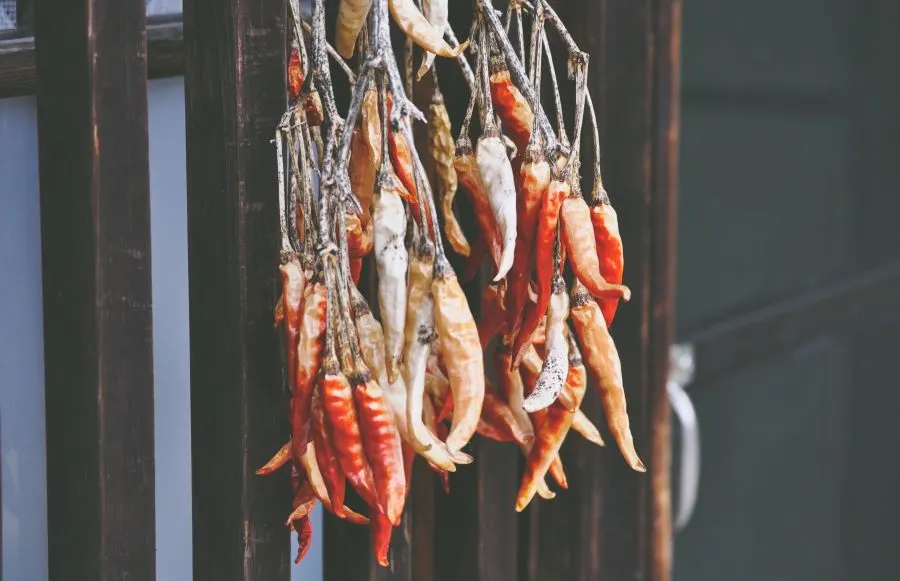Habanero peppers are best known for their fruity taste and spicy heat level. However, while they are relatively cheap to buy fresh, keeping them preserved is another matter.
Like most fruits and vegetables, habanero peppers have a relatively short shelf life unless you employ an effective method for preserving them. Of the many methods available, dehydrating habanero peppers is a great long-term option.

After harvesting your habaneros, you have to decide how you will use them. By dehydrating the peppers, you’ll remove the one component that is most likely to spoil them over time: moisture.
However, the trick is to dehydrate them in the right way so that you can enjoy the peppers for months to come. In this article, we’ll help you learn how to properly dry habaneros for long-term storage.
Skip Ahead:
- With a dehydrator
- Without a dehydrator
- Storing dried peppers
- Grinding dried peppers
- Re-hydrating dried peppers
- Other preservation methods
Methods Of Dehydrating Habanero Peppers
There are two major techniques for drying fresh produce. If you have a dehydrator, great! But if you don’t, you can still get the job done.
Using a dehydrator:
Using a food dehydrator is the most consistent method for dehydrating produce. These appliances are designed to pull all of the moisture from the habanero peppers.
Placing them in an oven on low temperature will remove moisture, too, but will usually cook the peppers slightly. This will turn the outside a darker color and take away some of the original flavor.
What you need is a proper food dehydrator that will dry the peppers in an even manner without cooking. This is accomplished by setting a very low temperature and providing constant air circulation. Skip to this method.
Without a dehydrator:
For centuries, peppers have been dehydrated by hanging them outside and letting the sun and wind pull away their moisture. While effective, natural dehydration does have drawbacks, from uneven drying, to the potential for mold or mildew.
If you live in a humid climate, air drying will not be ideal. Not to mention that a good rain can set back the dehydration process as well. Air drying is ideal for those who live in arid climates like the Southwestern US.
You can also use an oven to dehydrate, but this can cause discoloration and unwanted cooking if the temperature is too high. Skip to this method.
Curing habaneros before dehydrating
Curing is the process of allowing fresh produce to rest in a warm, dark location for a few days before fully drying. This allows time for the flavors to develop and sugars to concentrate.
I recommend placing fresh habaneros in a brown paper bag for about 3 days in a warm location with good air flow. This can have a drastic impact on the flavor of the dehydrated peppers, improving overall aroma and taste.
Avoid curing any peppers that have imperfections to avoid rotting fruits. After curing, move on to full dehydration.
Dehydrating Habanero Peppers in a Dehydrator
This method of dehydration works for all pepper varieties, including habaneros, jalapeños, bell peppers, banana peppers and many more. We use this 4-tray dehydrator for all of our food drying needs.
First and foremost, get a pair of gloves and be careful around the eyes. Whether you are an expert on being careful or not, all it takes is one drop on one finger that touches your eye to make you wish you’d never heard of habanero peppers.
Gloves will keep the pepper oils from gathering on your fingers, while goggles or glasses can remind you not to touch your eyes. If you do get a burn, use our guide to cure a skin burn here.
Wash your hands before and after handling the peppers just to be safe. Wash the peppers to remove any dust, dirt, or other unwanted debris from their skin.
Steps:
- Wash and dry the peppers. Carefully wash all the fresh habaneros with cold water, removing as much soil as possible. Dry the peppers with a towel afterward to avoid extended dehydration times.
- Sort the peppers. Place the peppers into a large bowl or container and separate the good ones from the bad. This means separating habanero peppers that have any imperfections like soft spots or mold. These may be harbingers for rot or mold, even after they have been dehydrated. Once you have separated them, put the bad peppers away for another short-term use.
- Cut the peppers (optional). With only the healthiest peppers remaining, cut them in half length-wise so they dehydrate more quickly. If you enjoy the seeds and membrane, more power to you! However, you can always remove them if you prefer less heat. You can also leave the peppers whole, though they will take much longer to fully dry. If you prefer to have the dehydrated peppers whole, cut a few slits in the skin of each habanero to ensure more even drying.
- Arrange the peppers on trays. Arrange the prepared habaneros on the dehydrator trays in a single layer. It is okay to space them close to one another, just don’t overlap. Insert the trays into the dehydrator.
- Begin dehydrating. Depending on the type and brand of dehydrator that you use, it should be heated to between 115°F and 125°F. The heat is set this low to prevent cooking while drying out the peppers.
- Check on peppers after 6-8 hours. Once the peppers crack and crunch upon squeezing, they are completely dried. You can also dry them for less time, aiming for a slightly flexible, leathery texture.
What is the best dehydrator to buy?
We use the Excalibur 2400 dehydrator for drying habaneros and other fruits and veggies. Excalibur dehydrators are known for their even drying and precise temperature setting. We highly recommend this unit if you’re on the hunt for a new dehydrator!

How long does it take to dry habaneros in a dehydrator?
Proper dehydration is a slow process, so its a good idea to start early in the morning. Typically, habanero peppers take between 10-12+ hours in a dehydrator on low heat to be fully dried. Once the peppers crack when squeezed, you know that they are fully dried.
After the first 6-8 hours, check on the peppers every couple of hours to note the progress of their drying. Peppers will store best after reaching a leathery or brittle texture.

Can you over-dehydrate peppers?
In short, it is basically impossible for peppers to be over dried, though some prefer to stop drying before they become brittle. Peppers can be stored when slightly flexible (leathery) or fully crackable (best for making powder and spices).
However, don’t forget about them during the dehydration process, especially if you are using an electric dehydrator.
Tip: Remember to wear gloves, even when checking peppers. Habaneros are potent!
What temperature is best to dehydrate peppers?
Some dehydrators don’t have a temperature setting, and some do. In the case that your dehydrator does have a temperature setting, select between 115-125°F. This will allow thin peppers to dry in about 10-12 hours.
Higher heat will dry habanero peppers faster, but they may lost more flavor and/or color in the process. If you are drying thicker peppers, you will likely have to dehydrate for longer to reach a fully dried state.
How To Dry Peppers Without A Dehydrator
If you would rather not purchase a dehydrator to dry out your peppers, you have a couple of other options. While a dehydrator offers the optimal conditions, using a conventional oven on the lowest heat setting will work. Or, you can simply use a fan aimed at the peppers.
Using an oven to dehydrate habaneros
Most ovens have a low-temperature limit in the range of 200°F. This temperature will cause peppers to cook slightly during the drying process, so timing becomes more important for drying out peppers.
- Set the oven to the lowest temperature. This is usually around 200°F.
- Clean the peppers. Wash and dry the peppers thoroughly. Slice them in half and remove the seeds (optional).
- Use a non-stick pan without oil. Place the peppers on the sheet with at least 1 inch of space between each other. If you have a cookie drying rack that is oven safe, use that to arrange the peppers for more even and fast drying.
- Dry for 12-24 hours. After the initial 8-10 hours, begin checking on the peppers every 2 hours or so, removing any smaller peppers that are fully dried. Be careful not to dry for longer than is necessary to avoid losing flavor and color.
Tip: If you have a convection oven, use the air circulation mode. If not, try leaving the oven door slightly open to allow more air circulation and to reduce heat slightly inside the oven. This may seem wasteful, but it can help reduce the likelihood of the peppers cooking.
Using a fan to dry peppers
For this method of dehydrating peppers, a large, tilting floor fan works best. Face the fan directly at the sliced peppers on a plate, and turn the peppers every few hours or so for even drying.
You will know that the peppers are dried when squeezing them causes the peppers to crack. If they are still soft, make sure they are leathery and lack any significant moisture. This process can take a number of days rather than hours, depending on humidity and temperature.
How to hang-dry peppers
Another option is to hang peppers outdoors to dry. This is a classic method that has been used for centuries, and will work best if you live in an arid climate. If humidity is above 50%, this method will take significantly longer.
In high-humidity climates, you are better off just using the oven or an indoor fan. This method is great for habaneros, but we don’t recommend it for thicker pepper types.
Steps:
- Prepare a needle and thread. Use a strong thread, capable of holding your peppers and withstanding gusts of wind. This could be a fishing line or any other strong thread.
- Knot the first pepper. Tie a strong knot around the first pepper’s stem. Make sure this is double or triple-knotted to ensure your peppers will not fall off.
- Thread the rest of the peppers. Using the needle, poke through each pepper at the base of each stem. For habaneros, you can usually put 15-25 peppers per thread since they are lightweight. Heavier pepper varieties may hold fewer.
- Hang the peppers. Tie the peppers in an area where they will receive lots of airflow and where the air is dry. Outdoors in a sunny balcony or near a doorway is usually best. You can also hang the peppers inside in the kitchen or somewhere that gets lots of airflow.
How To Store Dehydrated Habanero Peppers
Once the peppers are sufficiently dried, you should set them aside to cool for about an hour. Once cool, put them into an airtight container, then keep the peppers in a cool, dry place for storage. Try using Ziploc freezer baggies and removing as much air as possible before sealing, or a sealed ball jar. For the best long-term storage, use a vacuum sealer.
Tips on keeping dried peppers from spoiling:
- Avoid direct sunlight (pantry or cabinets are best)
- Use desiccant packets
- Use glass mason jars, sealed tightly
- Avoid moisture – if the peppers or their container gets wet, remove the peppers and allow to fully dry
By following these guidelines, you can keep dried habanero peppers for 1 year or longer. This means that you can have dehydrated peppers year-round to spice up your meals.
How To Grind Dried Peppers
Once you have dried peppers, you can either store them whole for later use, or use them to create tasty pepper flakes and powders. It is recommended that you only grind up dried peppers as needed. Keeping them whole until you’re ready to use them will best preserve the flavor.
Use a spice grinder
When peppers are sufficiently dried, they will quickly turn to a powder using a spice grinder or a blender. However, there are some precautions to take. Due to the extremely dried nature of the peppers, grinding them can cause a spicy dust cloud.
Be careful to avoid getting pepper dust in the eyes and sinuses by using these safety measures before grinding:
- Work outdoors if possible
- Cover your grinder or blender with a damp towel
- Wear a sealed face mask
- Wear eye protection
Tip: Blending for too long can cause the peppers to turn into dust rather than flakes. If you prefer a fine powder, brittle dehydrated peppers will work best.
Using a spice grinder is the quickest method for grinding dried peppers. Be sure to only use the blender for as long as necessary to reach the desired consistency.
Use a mortar & pestle
Mortar and pestle is the classic method for grinding up herbs, spices, and dried vegetables. It will take a bit more elbow grease, but a standard mortar & pestle will do the job just fine. This technique is ideal for making spicy pastes and sauces for homemade meals.
This method also avoids the potential hazards of sending hot pepper dust into the air. It will take longer, and is best suited for making flakes rather than a fine pepper powder.
See some of the other ways to use your dried peppers here.
How to Re-Hydrate Dried Peppers
If you want to reconstitute your dehydrated peppers, soak them in plain, hot tap water for about 10 minutes. If the peppers float, keep them submerged with a plate or other heavy dishware.
This will not restore the peppers to their original shape and size, but they will regain some of the weight and moisture of a fresh pepper. This is step 1 if you want to re-use your dried peppers for homemade hot sauce.
Other Methods of Preserving Habaneros
If you are interested in learning other ways to keep your hot peppers for longer, try one of these articles on Pepper Geek:
I hope this article helped you learn about dehydrating habanero peppers at home. Habaneros are amazing peppers to grow, and drying helps us enjoy them year round!



David Niemi
Tuesday 24th of October 2023
One other tip -- if you take a glove off, be sure not to put it back on inside out, or it will soon be the Glove of Pain. I learned that the hard way while processing Dorset Naga peppers yesterday (which are about 4 times as hot as habaneros). But I've gotten even worse chili hand from cutting up medium-hot or even low-heat peppers like Poblano, if there is a lot of contact with your hands for a long time period. On the plus side, with the Glove of Pain incident all other pain in my body completely went away for a couple of hours.
peppergeek
Wednesday 25th of October 2023
Wow, that is a big whoopsie. Hope you were able to get the pain under control quick. Sounds brutal..
Phil DiCaprio
Friday 20th of October 2023
Hi Calvin, love your site! I have a LOT of habaneros this year (17 plants - I have no idea what I was thinking!)
I have dehydrated a lot of them and turned into habanero powder. Is there a recipe for hot sauce using habanero powder? Also, is there a conversion for powder for use in recipes (like 1/2 tsp powder = 5 fresh peppers)?
Thanks!
Sav
Wednesday 23rd of November 2022
Hello Calvin, Thank you much for the ways mention above to dry habanero. I grew them this yr for the 1st time and have harvested a medium size pan. Some I will freeze, but I deffo want to try some of your ways to save them dry. Keep up the good work.
Ismene
Sunday 9th of January 2022
Love the website as I have only just started growing peppers (Capsicums in Australia). Am interested in drying them. I love paprika- not hot- on avocados and the store bought bottle tastes stale. I was interested in your mention of a short shelf life in your recent post. The bottle gives no information about the variety of peppers used - I suspect the seasonally cheapest may be used. Also, it is difficult to find the non-hot paprika in shops. May I ask please, what variety should I grow that tastes good, it not to challenging to grow, and suitable for drying? Thank you, Ismene.
peppergeek
Monday 10th of January 2022
I would recommend something like the sweet cherry pepper, new mexico pepper, or maybe a red bell. Any sweet red pepper can be used to dehydrate and make paprika powder. Hope this helps!
Jo Ann Salvisberg
Wednesday 23rd of September 2020
Thanks for your detailed instructions on drying habaneros. I will follow them using my Excalibur dehydrator. Can I dry other types of peppers at the same time (jalapeños, poblanos, Anaheims, Hatch, cayenne)? It was a very good year for my pepper plants!
peppergeek
Thursday 24th of September 2020
Yes! We pack our dehydrator full of all different varieties of peppers. However, we do try to keep super hot peppers separate from non-spicy varieties to avoid any cross contamination.
Hope this helps and glad you're getting a big harvest! -Calvin